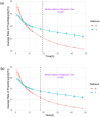The Relationship Between the Average Infusion Rate of Propofol and the Incidence of Delirium During Invasive Mechanical Ventilation: A Retrospective Study Based on the MIMIC IV Database
- PMID: 40018993
- PMCID: PMC11868985
- DOI: 10.1111/cns.70273
The Relationship Between the Average Infusion Rate of Propofol and the Incidence of Delirium During Invasive Mechanical Ventilation: A Retrospective Study Based on the MIMIC IV Database
Abstract
Background: Delirium is a common complication observed in intensive care units (ICUs). Propofol is one of the most widely used sedatives and is believed to be closely connected with the incidence of delirium. The study was carried out to explore the relationship between delirium and the average rate of propofol infusion.
Methods: Patients who underwent invasive mechanical ventilation (IMV) while receiving propofol from the Medical Information Mart for Intensive Care IV (MIMIC IV) database were included in the study. The primary outcome was to identify the potential risk factors for the incidence of delirium and investigate the relationship between the average rate of propofol infusion and the incidence of delirium. The secondary outcome was to further analyze the relationship by subgroup analysis. Propensity score matching (PSM) was employed to minimize bias.
Results: A total of 16,956 patients (delirium: 5805; control: 11,151) were ultimately included in the study after PSM. The median diagnostic time of delirium was 18 h. An average propofol infusion rate ≥ 20 μg/(kg*h) during the initial 18 h was found to be independently significant [OR = 1.84, 95% CI = (1.72, 1.98), p < 0.001], while an average propofol infusion rate ≤ 40 μg/(kg*h) in the first hour showed no statistically significant difference in the incidence of delirium [OR = 0.95, 95% CI = (0.88, 1.02), p = 0.163]. Besides, an average propofol infusion rate ≥ 20 μg/(kg*h) was also found to be statistically significant in all the subgroup analyses.
Conclusion: An average propofol infusion rate ≥ 20 μg/(kg*h) during the initial 18 h was identified as an independent risk factor for delirium, suggesting that the accumulation of propofol might be associated with an increased incidence of delirium.
Keywords: delirium; invasive mechanical ventilation; odds ratio; propofol.
© 2025 The Author(s). CNS Neuroscience & Therapeutics published by John Wiley & Sons Ltd.
Conflict of interest statement
The authors declare no conflicts of interest.
Figures




References
-
- Mattison M. L. P., “Delirium,” Annals of Internal Medicine 173, no. 7 (2020): ITC49–ITC64. - PubMed
-
- Devlin J. W., Skrobik Y., Gelinas C., et al., “Clinical Practice Guidelines for the Prevention and Management of Pain, Agitation/Sedation, Delirium, Immobility, and Sleep Disruption in Adult Patients in the ICU,” Critical Care Medicine 46, no. 9 (2018): e825–e873. - PubMed
-
- Lundstrom S., Twycross R., Mihalyo M., and Wilcock A., “Propofol,” Journal of Pain and Symptom Management 40, no. 3 (2010): 466–470. - PubMed
-
- Heybati K., Zhou F., Ali S., et al., “Outcomes of Dexmedetomidine Versus Propofol Sedation in Critically Ill Adults Requiring Mechanical Ventilation: A Systematic Review and Meta‐Analysis of Randomised Controlled Trials,” British Journal of Anaesthesia 129, no. 4 (2022): 515–526. - PubMed
-
- White N. C., Cowart C. R., and Cios T. J., “Pharmacological Prevention of Postoperative Delirium in Adults: A Review of Recent Literature,” Current Neurology and Neuroscience Reports 24 (2024): 681–689. - PubMed
MeSH terms
Substances
Grants and funding
LinkOut - more resources
Full Text Sources
Medical
Miscellaneous

